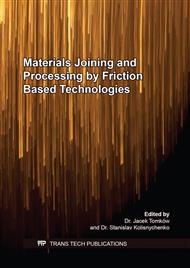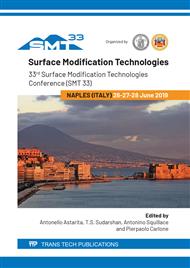p.381
p.387
p.393
p.399
p.404
p.411
p.417
p.423
p.429
Effect of Multi Pass Friction Stir Processing on Surface Modification and Properties of Aluminum Alloy 6061
Abstract:
In the present investigation, friction stir processing (FSP) is carried out with multi pass processing having 100 % overlap zone on the workpiece material of aluminum alloy 6061 with constant FSP parameters and varying multi pass processing conditions. Novel processing concept of multi pass FSP was performed with different rotation directions (such as clock wise and anti-clock wise directions) and processing directions (such as forward, reverse and revert directions). Surface inspection, macrographs and microstructures of the processed regions are evaluated and compared with each other. Multi-pass FSP with 100 % overlapping of two passes caused intense dynamic recrystallization and resulted in reduced grain size. Hardness of processed zone was found increased in case of two pass FSP. Minimum tensile strength was reported with double sided FSP compare to single pass and two pass FSPs. No major variations in tensile strength were reported in case of single pass and two pass FSPs.
Info:
Periodical:
Pages:
404-410
Citation:
Online since:
July 2019
Authors:
Price:
Сopyright:
© 2019 Trans Tech Publications Ltd. All Rights Reserved
Share:
Citation:



